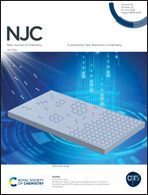Scalable fabrication of LDH-based adsorbent for the removal of nitrate with enhanced performance†
Abstract
The exploration of LDHs for the selective adsorption of NO3− from water has been proposed for a long time; however, their complex fabrication methods and unclear adsorption mechanism limit their further utilization. Considering this, herein, a systematic investigation was conducted by synthesizing Mg3Al-LDHs with different morphologies via the co-precipitation method with different alkali sources including individual NaOH and Na2CO3, and mixed alkali sources of NaOH and Na2CO3 to remove NO3− from water. Their detailed microstructure and morphologies were characterized and the influence of the alkali source on the NO3− removal rate for the Mg3Al-LDHs was fully investigated. Based on the results, LDHs prepared with NaOH as the alkali source could weaken the agglomeration of the Mg3Al–LDH layers, thus exposing the active adsorption sites on their surface and reducing their mesoporous pore size to 3.38 nm, which enhanced their adsorption capacity for NO3−. Consequently, the adsorption performance of LDHs for NO3− was investigated considering the influencing factors including time, temperature, and initial concentration. It was found that the sorption process could be well described by pseudo-second-order kinetics and the Langmuir isotherm model. The maximum monolayer adsorption capacity on NO3− was calculated to be 6.1 mg g−1 at 298 K. Meanwhile, the thermodynamic results indicated that the adsorption removal of NO3− is spontaneous (ΔG0 < 0) and exothermic (ΔH0 < 0). Additionally, the enhanced adsorption performance is attributed to the combination of physisorption driven by intermolecular forces and chemisorption caused by ion exchange. Therefore, due to the scalable fabrication of Mg3Al-LDHs with the addition of NaOH as an alkali source, they can be a potential adsorbent for the removal of NO3−–N from water.



 Please wait while we load your content...
Please wait while we load your content...